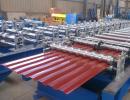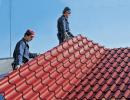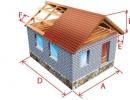Scope roofs and their designs: species, knots and a straight roofing device
The roof of the house is the final element of the external architectural appearance of any building. It carries out technical functions and, at the same time, is an ornament that can give the house a special memorable appearance. Scope roofs and their designs are complex engineering structures, and the comfort will depend on their proper arrangement and the comfortable stay of people living under it. The builder's handbook gives a clear concept, which is meant by the words "Roof" and "Roof".
The roof is the top of the house covering it and protecting against the negative effects of the environment and precipitation, such as rain, snow, solar radiation, cold and hot atmospheric air, etc. In a broad sense, the roof is a construction that perceives the load from atmospheric precipitation and wind effects, as well as the weight of its outer layer (finishing).
The roof is the upper element of the roof, its coating that protects the house from all sorts of external influences. It carries both technical functions and decorative, representing a kind of reliable and beautiful tent covering the house.
The roofs are flat and inclined. In the latter, the surface of the roof has a slope (skat) towards the outer walls. Depending on the shape of the skate, inclined roofs are
- single one;
- tents;
- forcepets.

The pitched roofs are the most different shapes - conical, pyramidal, spherical, etc. Our climatic conditions and established traditions of tradition made the pitched roofs in the most popular in country construction. This article will be devoted to this type of roofs. It will help individual developers to choose the right structure of the roof and competently carry out control during its construction. What it will be and from what material will be made, determine at the design stage. Much depends on the architectural type of the facade of the building and the technology of the roofing device.
Basic on the pitched roof
These types of roofs belong to the scope of which the surface of the roof is inclined toward the outer walls. Such a device makes it possible to naturally drain rain and tal waters.
The angle under which the skate is tilted to the horizon, it is customary called the corner of the roof. It is expressed in degrees. Basically, the pitched roofs have an angle of at least 5 °. There are cases when individual roof sections may have an angle of inclination of 90 °. What a scope roof device and its inclination angle will need for your home, will depend on the climate, the general architecture of the house and from the selected material for the finishing coating. For example, where there is a large amount of precipitation, and the roofing coating is a loose (metal tile), roofing skates need to be made steep. Where strong winds often blow, in order to reduce wind pressure, the roofs are arranged by more gentle. If you correctly choose the roof slope, then you can reduce the cost of building a house. Cool roofs are more expensive because they require large labor costs and materials.
The attractive shelter roofs are their diversity. The shape and kind of roof is chosen by taking into account the appointment of the construction and its plan. But, in any case, it should carry out a qualitative removal of water that flows through it during the period of melting of snow and in the rainy course of the year. Scope roofs can be equipped with an attic or be without it, as well as to have a mansard residential room.
Varieties of pitched roofs
Rock roofs in their own way can be:
- single. This is the easiest of the shape of a slope, which takes water only in one direction. They are used to cover small houses, attachments to the house, porches, temporary structures and household buildings. All of them are built without a attic or have annetsol in the area under the roof;
- double. It is suitable, as a rule, in low-rise buildings. It possesses two slopes or inclined planes that have a rectangular shape. The side parts of the triangular walls used in the device of such a roof are the name of the frontath;
- four-tight or tents formed from two-tight roofs. Triangular rocks in the tent roof device are called Valmami. The frontones of this roof over the entire height are cut into the inclined plane;
- polvalm. Their difference from the four-sheet roofs is that the inclined planes in such roofs are cut off only part of the fronton;
- four-fetch. In such roofs, four bounce planes are connected;
- mansard. Such roofs are needed when the attic space is used for residential rooms or for official purpose;
- conical and dome. They are arranged for overlapping buildings that have a round shape according to plan;
- pyramidal. Used in homes that have a square or form of the correct polygon. These high and stretched roofs are also called spiers.
The main parts of the pitched roof
The design of the pitched roof includes two types of basic elements - carriers and enclosures (it comes directly about the roof).
Carrier elements of pitched roofs are designed to accept loads from snow cover, wind pressure, the weight of the roof itself. With their help, there is a redistribution of loads on the bearing walls and separately located supports. All this places the strength of the bearing elements increased and fairly strict requirements.
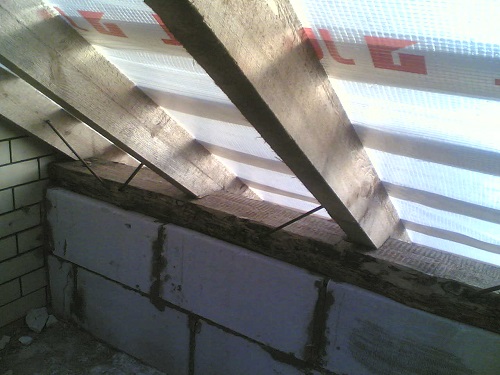
These include elements such as Maurylalat and a rapid flowing system.
In addition to them, there is a need for additional fasteners (racks, rifles, struts, pins, etc.). With their help, the rapid farm is given the desired rigidity.
Mauerlat is called a bar, which serves as a support for inclined wooden rafters. With it, the load created by the roof of the house is distributed. It can be noted as a kind of foundation for the entire roof design. In the classical version, it has a 15x15 cm cross section, but, as a rule, not less than 10x10 cm.
Mauerlat arrange in such a way that he can stretch for the entire length of the building or put it only under the rafter legs. When the cross section of the rafter foot is small in the width, then over time it can be saved. In order to avoid this, they use a special lattice, which includes a pump, racks and riglies. For the manufacture of racks and subposses use a 15 cm width board and 2.5 centimeters thick. You can also use wooden plates made of logs with a diameter of at least 13 cm. Maurylalat is placed on the upper edge of the wall - along its axis, as well as in the direction of the outer and indoor edge (dependence on the design of the roof and walls).
It is better not to install Maurolat closer than 5 cm from the edge of the external planes of the walls. It should be securely attached to the wall, since the roof can be compared with a large sail, which under the impression of the wind can be, if not torn, then somewhat moved, which is extremely undesirable.
According to the tradition, the material for Mauerlat is a tree, but in the manufacture of a roofing frame made of metal, you can use a chaserler, a 2-way and other metal products.
The laying of Mauerlat is carried out by laying from the waterproofing material (for example, rubberoid) at an altitude of not less than 40 cm from the top of the attic overlap. Every 3-5 meters, the runs should be based on the racks that are lying on their lower ends in the litter. The angle located between the rafter foot and the subproof should be approximate to 90 °. When the drunk roof device provides that the rafting leg has a large length, the installation of additional supports, which are a sozer-based leafing on the ice. Since each link, Mauerlat is associated with two units located in the neighborhood and simultaneously attach them to rafters, then as a result, a steady reliable design is obtained from the entire perimeter of the roofing system. You can put in separate segments to put Mauerlat under the rafter legs.
When they talk about the rapid roof system, it is about the supporting structure of the pitched roof, which includes inclined rafter legs, vertical racks and inclined pods. The rafters can be made of wood, reinforced concrete, metal and mixed materials. With the help of such fasteners, as a pump, riglels, racks, struts, and the like. The rafters are connected to the rafting farms (systems).
The rafting system is formed on such a geometric shape as a triangle. The reason is that due to this, it is the most stable and tough.
For rafters, a timber with a different cross section is used, it is determined by the length of the rafter legs, the step of the sling unit and the calculated load (snow, wind) for a particular region. For simple construction designs, the recommended section of the section oscillates within 40x150 mm and 100x250 mm.
Slinge systems can be C:
- double farms;
- farms with the top belt of complex shape;
- scissor farms;
- mansard farms.
About types and varieties of rafter systems
On the features of the construction of the rafter systems, the location and number of internal supports, the form of the roof itself, the magnitude of the span between the supports acting on the load crate and other factors are affected.
The main element of the rafter system is the rafting legs that support the crate. They are accepted along the roofing skate.
Farm design can be equipped with the use of rafted two types - weapons, which are based on the end and middle part on the walls of the building, and hanging on the walls of the building only by the ends without the use of intermediate supports.
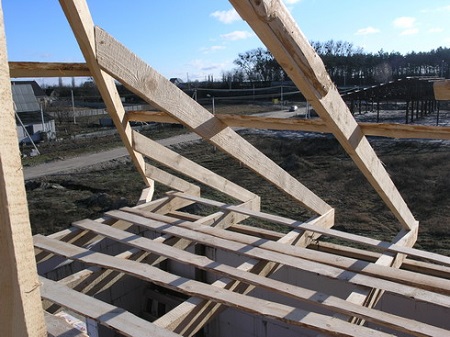
Hanging type rafters produce the transfer of the load into two extreme supports, the walls of the building can act in their quality. The legs of such rafters can work, both towards bending and towards compression. With their help, a driving force is created in the horizontal direction, which is very large and transmitted to the walls. Metal and wooden tightening helps to significantly reduce this effort. The arrangement of the tightening may be at the base of the rafted and above. The higher the tightening will be located, the more powerful it should be. The material from which it is made in this case does not matter. Such a scope roof, the nodes of which are securely connected to the rafters, is stable and durable.
Because in the hanging rafters, the support is carried out only at two extreme points, the tightening, which connects the rafting legs, does not allow them to drive around. When the span is less than 8 m, to reduce the deflection of the rafting legs, the rigl is crashed parallel to the tight. With a span more than 8 m, a grandmother with a pink. Hanging rafters enjoy in facilities with light walls. Their great advantage is that they can overlap long spans.
Slingers of the utility type are used in buildings that have a middle carrier wall, and also have columnar intermediate supports. They are used when the distance between them is not more than 7.0 m. Additional support can increase the width of overlapping up to 12 m, and the presence of two to 15.5 m. Stropile legs in wooden houses (brusted or chopped) have a support on the upper crowns, In the frame - on the upper strapping. In the houses of stone, Maurylalat will serve as a support for the rafter feet.
From this it can be seen that the end of the rafter carry out the transmission of the load on the outer walls of the building, and their middle part produces the transfer of the load on the inner walls or supports.
Compared to other types of roofing systems, the roofing system using sprinkled rafters is easier in the installation. This will save timber, and therefore, the cost of construction is reduced.
In one roofing structure can be alternating hanging and rolling rafting systems. When there are no intermediate supports, hanging rafters are more appropriate, in other cases the setting of the spots.
There are roof designs when combined rafter systems are used when the alternation of the urban and hanging rafting systems occurs. To increase their rigidity under the ski run, set a rack with a pink. With this reception, you can increase the distance between the side supports within 12 meters.


